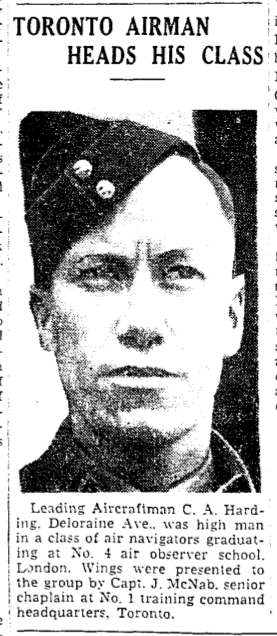

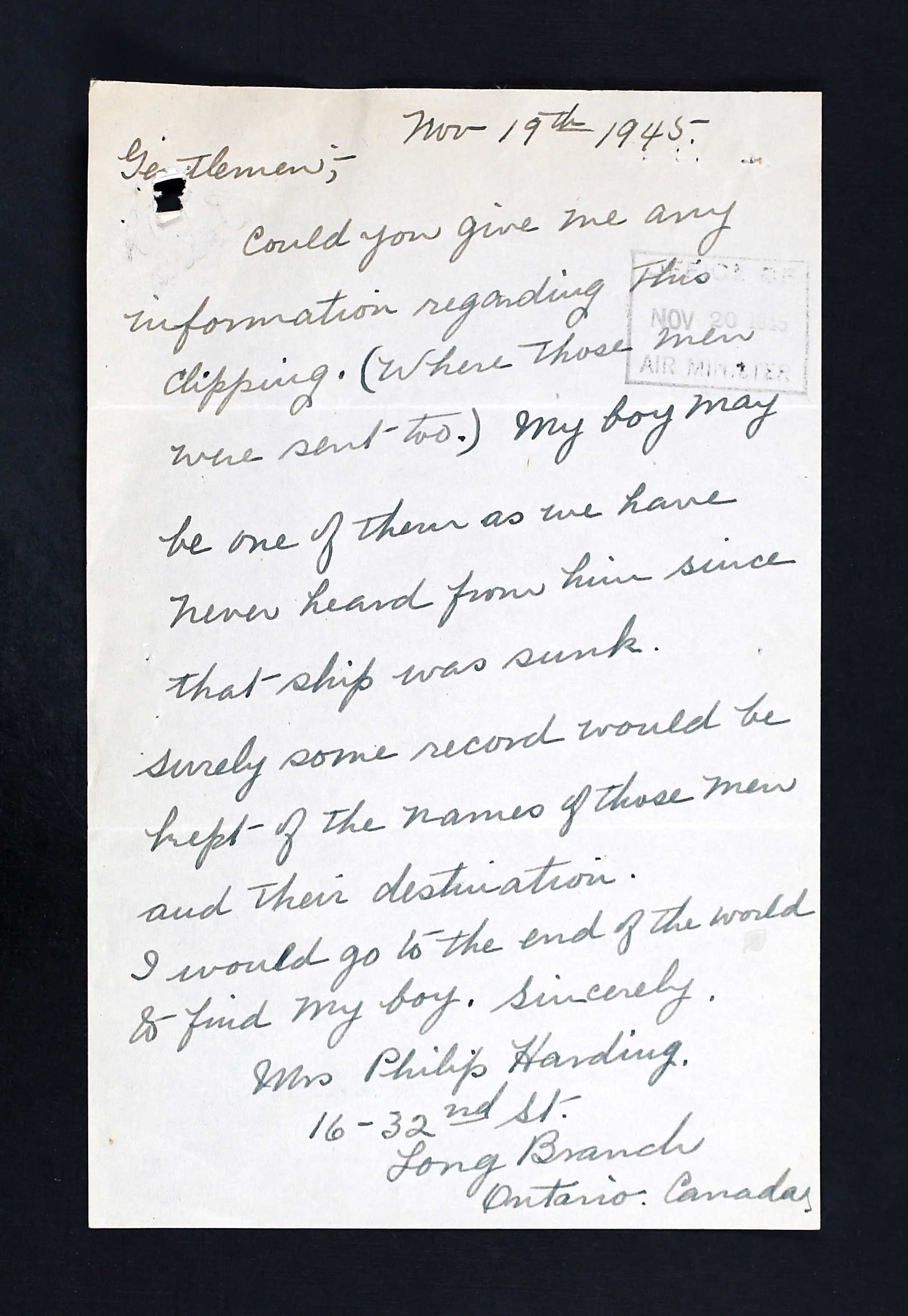
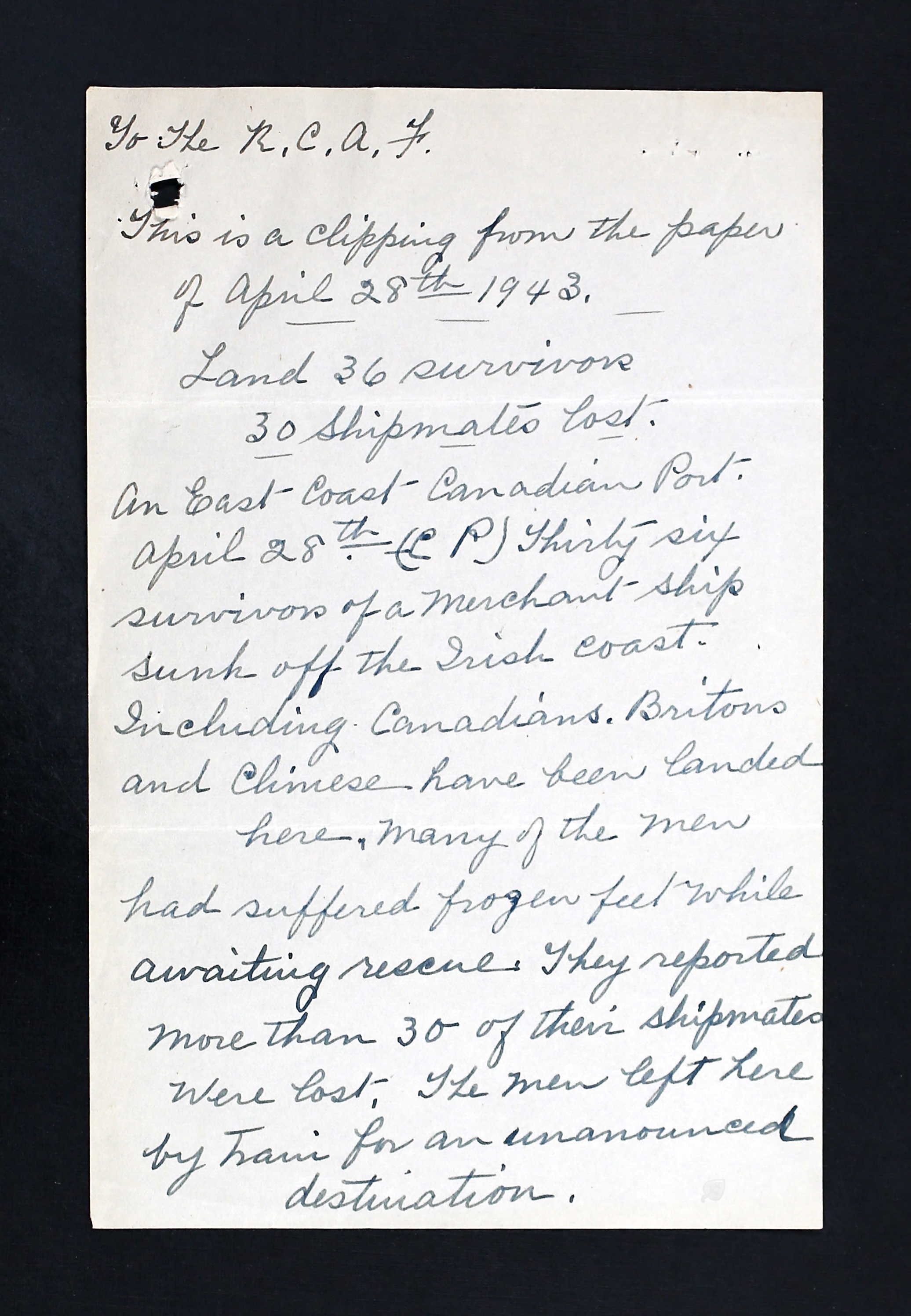
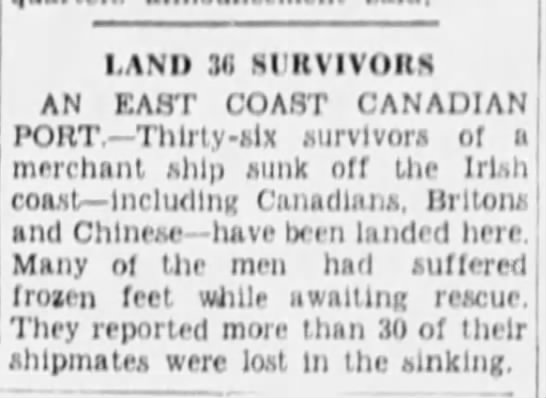
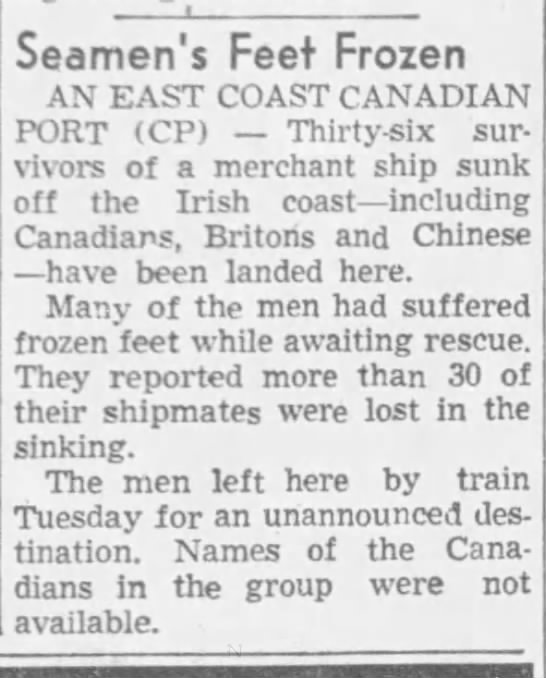
October 16, 1914 - April 22, 1943






Clifford Alexander Harding was born in Clifford, Ontario, Wellington County, to Philip Harding, carpenter, and his wife, Fanny (nee Weir) Harding. He had three older brothers: John, 42, Hamilton, Ontario, Samuel, 41, Toronto, and Henry, 37, Los Angeles, California, and two older sisters: Pearl, 35, who lived with their parents, and Mrs. Esther Leslie, 39, Chicago, Illinois. Two sisters died at childbirth (Margaret, 1912, Agnes, 1916).
Clifford married Velma Jean Elford on August 6, 1941 in Etobicoke, Ontario at a United Church. He made her the sole beneficiary of his estate, including $1107 in life insurance. His sister, Pearl, was the beneficiary of almost $200 in another policy.
On the RCAF Interview Report dated May 6, 1942, No. 11 Recruiting Centre, RCAF, Toronto: “Grade XIII education, Ontario, 1934, plus extension course in accountancy, employed recently in merchandising” with Dominion Rubber Ltd (1934-1939) and then was doing bookkeeping and statistics with McNeillie & Co (hide brokers) (1942). “Fit. Stable. Medium build, neat, clean, good appearance, pleasant personality, confident, sincere, keen. Engages in skating and softball moderately, has been driving cars for six years. Average family background. Made application for appointment September 23, 1939. Organized. Good aircrew material. Recommended for Observer or Pilot. Suitable for commission.” Clifford thought that after the war was over, he would like “to obtain a position with the Department of Statistics.”
On May 28, 1942, Clifford was accepted into service with the RCAF. He stood 5’5” tall, weighed 147 pounds, had a fair complexion, grey blue eyes and fair hair. He liked photography.
He was posted Moncton at Richibucto, New Brunswick, July 29, 1942 at No. 8 SFTS before being sent to an Initial Training School to start his training.
From September 14 to November 6, 1942, Clifford attended No. 3 ITS, Course 62, Victoriaville, Quebec. “Intelligent. Works hard and has a keen desire to make good. Good service spirit. Alternative recommendation: Air Bomber.” He earned 90% and was 30th out of 130 in his class.
In September 1942, he had another medical exam. “Night visual acuity quality: AA. Intelligence: average or above. Motivation: Wanted to serve and learn a new trade. Not keen about overseas because he just got married. Emotional stability: Very good. General Adjustment; Good. Comments: Older than usual -- 27. Well built. Serious, hard worker and with good moral habits. Was doing accounting work in civil life and is very much attracted by figures (maths). Would like to serve as an observer. Knows much about photography. Very good aircrew material.” F/L L. F. Belanger.
He was sent to No. 4 AOS, London, Ontario, from November 22, 1942 to March 19, 1943. “Thorough in anything he attempts. Neat logs, excellent chart technique, shows initiative in air work; good service spirit.” He earned 80% and was 2nd in the class of 23. He was awarded his Aircrew Navigator’s Badge on March 19, 1943.
On April 3, 1943, he was in Halifax awaiting transport overseas.
On April 22, 1943, Clifford was aboard the Amerika. German U-boat U-306, torpedoed the ship, south of Cape Farewell, off Greenland. Thirty six other RCAF airmen, plus forty-two crew members and seven gunners were also amongst those who were lost. The master, Christian Nielsen, 29 crewmembers, eight gunners, and sixteen passengers were picked up by the HMS Asphodel, and landed at Greenock. General cargo, including metal, flour, meat, and 200 bags of mail were also lost.
The thirty seven men's families received a letter from W/L W. R. Gunn in June 1943. It is unknown who in the Harding family received it. "Since my letter of May 6th, no additional news has been received. Attached is a list of the names and next-of-kin of sixteen Royal Canadian Air Force officers who embarked on the same ship as your son and following enemy action at sea were safely landed in the United Kingdom. The following official statement was made in the House of Commons....’I have been in receipt of communications from a number of members of this house and from people outside with reference to rumours regarding the recent loss of a number of members of the RCAF by the sinking of a ship in the north Atlantic and I desire to make the following statement on the facts. The vessel in question was a ship of British registry of 8,862 tons, designed for peace-time carriage of both passengers and freight, and having a speed of fifteen knots. She carried a crew of 86 and the passenger accommodation consisted of 12 two-berth rooms with bath and 29 other berths, providing cabin accommodations for 53 passengers. She was fitted with lifeboat capacity for 231 and travelled in naval convoy. Under the recently revised regulations agreed to by the United States authorities, the joint United Kingdom and United States shipping board, the Admiralty, the Air Ministry and the Canadian authorities, a vessel of this description travelling in convoy is permitted to embark as crew and passengers a maximum of 75% of the lifeboat capacity. The lifeboat capacity as stated above was 231, 75% of which is 173. Personnel on board consisted of the crew of 86, and RCAF personnel numbering 53, a total of 139, well within the prescribed limits. Because of the superior type of available passenger accommodation, the speed of the ship and the provision of naval convoy, the offer of the entire available space to the RCAF was immediately accepted. Rumours to the effect that this was a slow freighter not suitable for passenger accommodation are, of course, not in accord with the facts. Every precaution was taken to safeguard the lives of these gallant young men. It should be pointed out that on account of the serious shipping shortage every available berth on such ships must be used, and had the space not been taken up by the RCAF officers of the other arms of the services would have been placed on Board. It should also be stated again that the submarine is still the enemy’s most powerful weapon and that the Battle of the Atlantic is not yet won. Any ocean trip today in any part of the world is fraught with danger and I think I may safely say that our record in transporting our soldiers and airmen to the United Kingdom is one of while we may all be proud. No one deplores more than I do the loss of 37 of the finest of our young men who gave their lives for their country as surely as if they had done so in actual combat with the enemy, and I extend my deepest sympathy to their loved ones in their bereavement.’ "If further information becomes available, you are to be reassured it will be communicated to you at once. May I again extend to you my sincere sympathy in this time of great anxiety."
On November 19, 1945, Clifford’s mother wrote to the RCAF: "This is a clipping from the paper of April 28, 1943. Land 36 survivors 30 shipmates lost. An east coast Canadian Port. April 28 (CP) Thirty six survivors of a merchant ship sunk off the Irish Coast. Including Canadians, Britons, and Chinese have been landed here. Many of the men had suffered frozen feet while awaiting rescue. They reported more than 30 of their shipmates were lost. The men left here by train for an unannounced destination. "Could you give me any information regarding this clipping? (Where those men were sent to?) My boy may be one of them as we have never heard from him since that ship was sunk. Surely some record would be kept of the names of those men and their destination. I would go to the end of the world to find my boy."
In late October 1955, Velma Harding received a letter from W/C Gunn informing her that since Clifford did not have a known grave, his name would appear on the Ottawa Memorial. She was residing in the same home she had lived at since her marriage to Clifford: 372 Deloraine Avenue, Toronto.